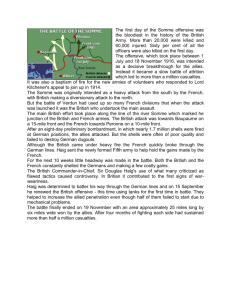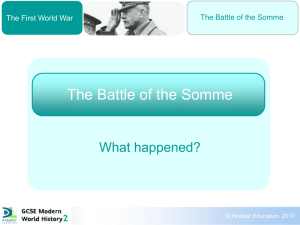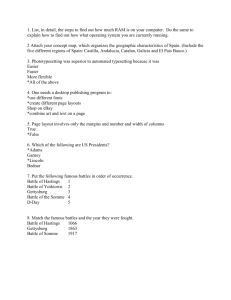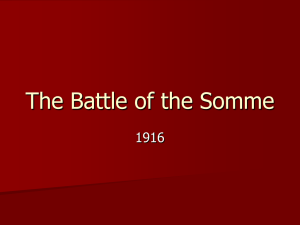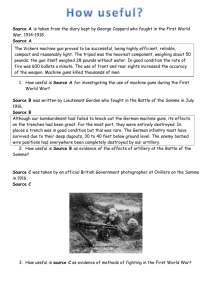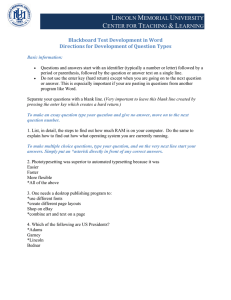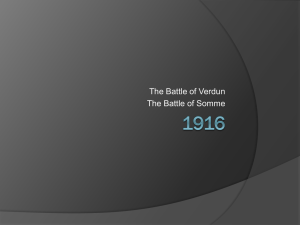Background Events leading to the battle
advertisement
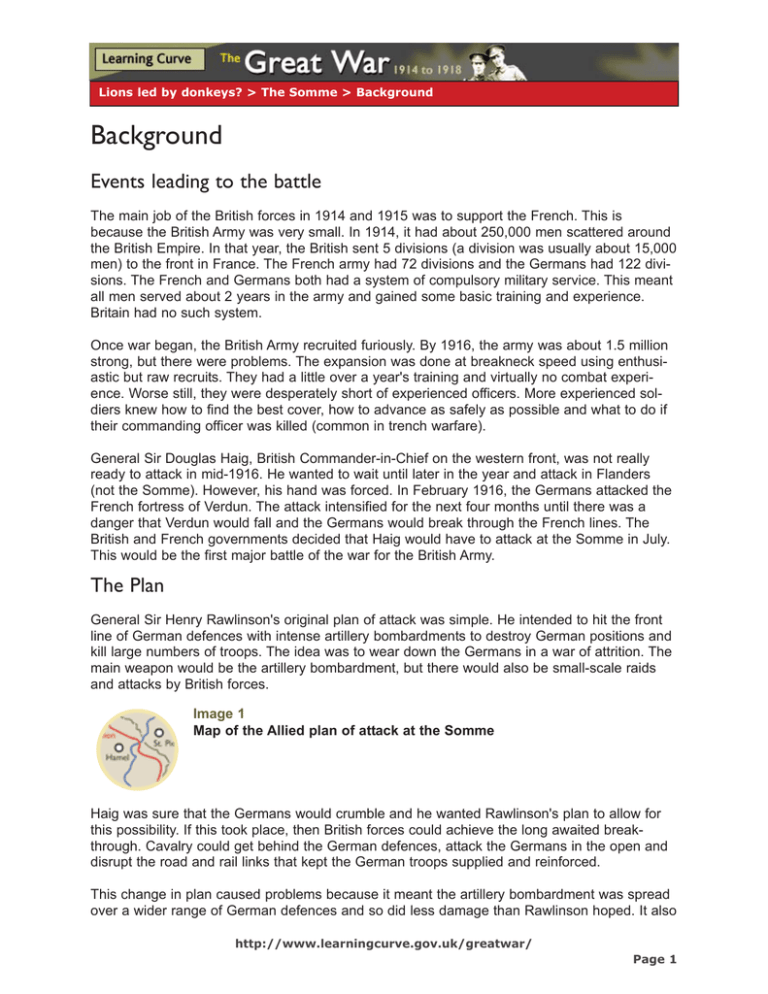
Lions led by donkeys? > The Somme > Background Background Events leading to the battle The main job of the British forces in 1914 and 1915 was to support the French. This is because the British Army was very small. In 1914, it had about 250,000 men scattered around the British Empire. In that year, the British sent 5 divisions (a division was usually about 15,000 men) to the front in France. The French army had 72 divisions and the Germans had 122 divisions. The French and Germans both had a system of compulsory military service. This meant all men served about 2 years in the army and gained some basic training and experience. Britain had no such system. Once war began, the British Army recruited furiously. By 1916, the army was about 1.5 million strong, but there were problems. The expansion was done at breakneck speed using enthusiastic but raw recruits. They had a little over a year's training and virtually no combat experience. Worse still, they were desperately short of experienced officers. More experienced soldiers knew how to find the best cover, how to advance as safely as possible and what to do if their commanding officer was killed (common in trench warfare). General Sir Douglas Haig, British Commander-in-Chief on the western front, was not really ready to attack in mid-1916. He wanted to wait until later in the year and attack in Flanders (not the Somme). However, his hand was forced. In February 1916, the Germans attacked the French fortress of Verdun. The attack intensified for the next four months until there was a danger that Verdun would fall and the Germans would break through the French lines. The British and French governments decided that Haig would have to attack at the Somme in July. This would be the first major battle of the war for the British Army. The Plan General Sir Henry Rawlinson's original plan of attack was simple. He intended to hit the front line of German defences with intense artillery bombardments to destroy German positions and kill large numbers of troops. The idea was to wear down the Germans in a war of attrition. The main weapon would be the artillery bombardment, but there would also be small-scale raids and attacks by British forces. Image 1 Map of the Allied plan of attack at the Somme Haig was sure that the Germans would crumble and he wanted Rawlinson's plan to allow for this possibility. If this took place, then British forces could achieve the long awaited breakthrough. Cavalry could get behind the German defences, attack the Germans in the open and disrupt the road and rail links that kept the German troops supplied and reinforced. This change in plan caused problems because it meant the artillery bombardment was spread over a wider range of German defences and so did less damage than Rawlinson hoped. It also http://www.learningcurve.gov.uk/greatwar/ Page 1 Lions led by donkeys? > The Somme > Background meant that the attacking infantry were more spread out than Rawlinson planned. This was a problem because they were inexperienced troops and there were few experienced officers. The commanders were concerned that there would be chaos if soldiers charged forward and lost contact with their officers. This was the main reason why orders were given to walk towards the enemy positions. As history now shows, these tactics were disastrous and the senior commanders contributed to the huge death toll during the attack. However, it is important to remember that Haig issued those orders because he felt he had little choice. Units with experienced officers usually adapted the tactics and suffered fewer casualties than units with inexperienced officers. The Attack The attack took place on 1 July 1916. For a week before that, a huge bombardment of German positions had been going on. Most of the British troops expected the German defences to be badly damaged, but it is a myth that they were told that the Germans would simply surrender. Haig underestimated the strength of the German defences and his changes to the plan weakened the impact of the bombardment. Another problem was that about 30% of the 1.7 million shells fired by the British did not go off. The attacking British troops met extremely strong artillery and machinegun fire from the German defenders. There were some important successes at the southern end of the attacking line, but the troops at the northern end suffered huge casualties. Around 20,000 were killed and around 40,000 wounded. Controversy over The Somme There are few events in British history that carry as much significance as the Battle of the Somme. The battle has a dark reputation. The main reason for this is the heavy casualties. Whole villages or sections of towns lost a generation of young men. One of the most famous examples is Accrington in Lancashire. Their young men joined up together in 1915 to form a 'Pals' Battalion. Young men from local streets, factories, football and rugby teams joined up at the same time. The army thought that this local identity would make for good fighting units who would stick together in battle. There were other areas that supplied such units. The very first Pals Battalion was signed up in Liverpool. There were Birmingham, Manchester and Newcastle Pals. The 36th Division was made up mainly of Protestants from Ulster (mainly from the area which is Northern Ireland today). All of these units fought with great gallantry at the Somme. The trouble was it took only one heavy bombardment or one attack on a heavily defended position and a whole street or village lost its young men. Some parts of the country lost few or no young men, but this of course did not grab the headlines. The British Army changed its recruiting policy after the Battle of the Somme. Another controversy about the Battle of the Somme is whether the British commanders were to blame for the heavy losses because they were incompetent. The main accusations are usually directed at the British Commander-in-Chief, General Sir Douglas Haig. He is charged with not caring about the heavy casualties. He is also accused of failing to change his tactics when things were not going according to plan. He earned the unwanted title of 'the Butcher of the Somme'. But was this fair? http://www.learningcurve.gov.uk/greatwar/ Page 2 Lions led by donkeys? > The Somme > Background The casualties at the Somme were heavy, but only by the standards of previous British wars. British casualties at the Somme were similar to the losses which German, Austrian, Russian and French troops had suffered in many of the battles of 1914-15. This battle had such a huge impact on Britain because Britain had never fought in a war like this before. Most of Britain's wars had been wars in the empire or battles at sea. In both cases, casualties tended to be relatively low. With hindsight, we can see that Haig made mistakes and the first day of the Somme was a disaster. However, we also have to look at the limited options open to him. He was told to relieve Verdun and this meant attacking the Germans. Haig made mistakes by altering Rawlinson's plan, but he could not foresee that 30% of the British shells would fail to explode. Haig was criticised for sending men to capture enemy trenches, but no politician or military leader came up with any alternatives in 1916. It is very telling that most people at the time did not share the hostility later expressed towards Haig. Image 2 Haig being welcomed home from France, 12 April 1919 (Catalogue ref: ZPER 34/154, reproduced by permission of the Illustrated London News Picture Library) Links Battle of the Somme, 1916 http://www.firstworldwar.com/battles/somme.htm The excellent firstworldwar.com website gives a detailed account of the battle. The Accrington Pals http://www.btinternet.com/~a.jackson/pals.htm This website is dedicated to the memory of one of the units that suffered heavy casualties on the first day of the battle. Battle of the Somme http://www.spartacus.schoolnet.co.uk/FWWsomme.htm The Spartacus website provides an easy-to-follow story of the battle. The Somme http://www.cdli.ca/beaumont/somme.htm This gives a Canadian perspective on the battle. Tragedy on the Somme http://www.worldwar1.com/sfsomme.htm This is an emotional account of the battle, concentrating on the first day. The Ulster Division and the Battle of the Somme http://users.tibus.com/the-great-war/sommewww.htm This is an account of the experiences of the 36th Ulster Division, which suffered huge losses at the Somme. http://www.learningcurve.gov.uk/greatwar/ Page 3
